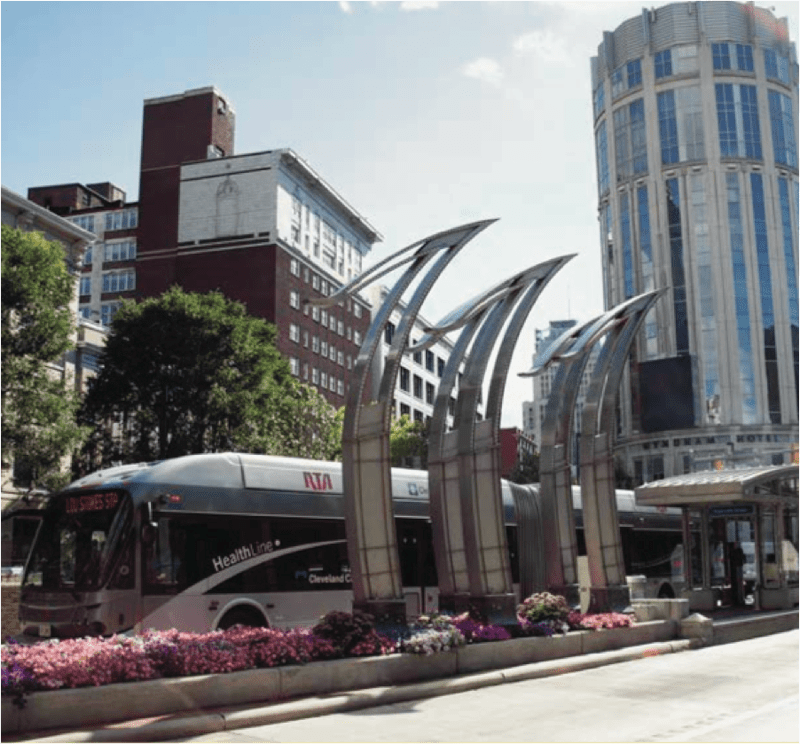Last week, Cleveland celebrated the 10th anniversary of its famous Bus Rapid Transit line, the Healthline. Inspired by the success of Curitiba, Brazil's famous Transmilenio BRT line, the project was meant to serve as a demonstration project for bus rapid transit in U.S. cities.
The "demonstration" worked as planned. Cleveland's $200-million, nine-mile project has inspired cities around the country, including Albuquerque's soon-to-open ART and Indianapolis's under-construction Red Line, and Richmond's just-opened "the Pulse."
The anniversary of the Healthline made us wonder: how are the earliest bus rapid transit examples in the U.S. performing?
A quick analysis, shows they are improving speeds and outperforming ridership projections. Here's a quick overview of a few of the oldest and best examples:
Pittsburgh's South/East/West Busways — 1977, 1983, 2000
Pittsburgh was way ahead of the game with bus rapid transit. The city launched its South Busway — a road built exclusively for buses — three years after Transmilenio opened in 1977. The 4.3-mile busway inspired several other local projects, the East and West Busways, which were constructed in the 1980s.
These "highways for buses" offer dedicated lanes, but lack some of the other features that make bus rapid transit so much speedier than standard bus service.
But they are still powerful people movers today and may help explain why Pittsburgh continues to outperform peer cities on transit commuting. The South Busway carries about 5,000 daily rides on the bus routes it serves, according to the Port Authority of Allegheny County. Meanwhile, the East Busway is the biggest people mover, carrying about 12,000, ridership that rivals Pittsburgh's Red Line light rail.
L.A.'s Metro Orange Line — 2005
L.A. Metro's Orange Line is a big, undersung success story.
This 18-mile bus rapid transit line serving L.A. San Fernando Valley carried about 25,000 daily rides in 2017, Curbed reports. That's well ahead of what the agency had originally projected: 22,000 daily riders by 2020.
While it is older than Cleveland's Healthline, L.A.'s Orange Line doesn't get any "respect," as the nation's best performing BRT line, Curbed's Patrick Sisson complained in 2017. Metro is set to improve service as well. The agency recently broke ground on a project that will build bridges at a couple of key crossings. The project is expected to shave 20 percent off travel times.
Cleveland's Healthline — 2008
Cleveland's Healthline includes most of the elements of a high-quality bus rapid transit system: off-board fare payment, center stations, level boarding, dedicated lanes, signal priority, carefully spaced stations. It also has relatively frequent, round-the-clock service. The $200-million price tag also included a complete street rebuild and streetscaping. The bus service features cost $50 million.
The Healthline has improved speeds. It averaged 12.5 miles per hour in its first few years of operation, compared to 9.3 for the bus it replaced. It also boosted ridership 60 percent compared to the old route serving Euclid Avenue within two years of service. In 2012, it was serving 14,200 rides per day [PDF]. And bus trips along the whole corridor were caring 21,000 rides. (The service it replaced carried 8,900.)
On the 10-year anniversary, Cleveland's Regional Transit Authority celebrated the line's success in spurring development — roughly $9.5 billion in construction projects since its opening. The return on investment, they told the Plain Dealer was $195 for every dollar spent.
The Healthline has had some bumps in the road. For years, service suffered because the city turned off some of the signal priority system, that was meant to give buses a jump on traffic at traffic lights. And last year a local judge ruled that the RTA's enforcement of its "proof of payment" system was unconstitutional. RTA had been using armed transit police to spot check every person aboard randomly selected buses for tickets. This saves time by avoiding lines at the entrance to the bus. But a local judge said it amounted to unlawful search.
Since the ruling — RTA tried to appeal, unsuccessfully — some riders say the system has slowed. Ridership plunged a stunning 18 percent year over year.
But RTA says while ridership is down, revenues are up 75 percent. Many of the previous riders were not paying.
Even after the change, the system was still generating a respectable 11,300 rides per day in 2018.
In addition, in 2017, the line brought in $4.5 million in fare revenues, almost as much as its $6.5 million operating costs — an amazing 73 percent farebox recovery rate.
Eugene, Oregon's Green Line/Emerald Express BRT — 2007, 2011, 2017
Opening in 2007, the $24-million Green Line brought faster bus service between Springfield and downtown Eugene, Oregon.
Prior to the project the bus service on this corridor averaged 11 miles per hour. The Green Line, with its mix of dedicated lanes and mixed traffic, brought average speeds up to 15 miles per hour. The line also boosted ridership 74% from 2,700 to 4,700 daily riders.
Since then "The Emerald Express" has been extended twice: in 2011 and 2017. It now provides service to West Eugene at 10 minute headways during daytime hours, with off-board fare payment and all-door boarding.
Connecticut's CTFastrack — 2015
Connecticut's CTFastrack, built at a cost of $550 million in 2015, has all the elements of bus rapid transit: level-boarding, off-board fare payment, dedicated travel lanes, center-aligned stations.
Running 9.4 miles between Hartford and New Britain, the line serves 12,000 rides a day, according to ConnDOT, and about 18,000 ride either the BRT or the bus lines feeding it. Prior to the construction of CTFastrack, the corridor averaged 8-9,000 trips. The line has exceeded ridership projections from the start and has started to generate some walkable development.
The line helped make Hartford one of the most-improved cities in job access by transit between 2015 and 2016, according to an analysis by the University of Minnesota.
Note: This article only examined early Bus Rapid Transit systems that the Institute for Transportation and Development Policy classified [PDF] as Bus Rapid Transit.





